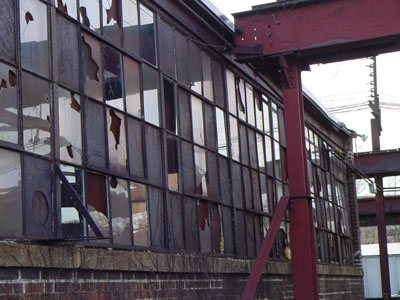The Uncanny Space of Decay
by Dylan Trigg
“Part from you friends at the station
Enter the city in the morning with your coat buttoned up
Look for a room, and when your friend knocks:
Do not, oh do not, open the door
But
Cover your tracks”
(Berthold Brecht, Handbook for City Dwellers)
What is it that draws us to dereliction, decay and abandoned spaces? The question is not an indulge of perversion since decay is often regarded as pernicious to the fabric of society, and as such the space of dereliction has become synonymous with the dissolute, the vagrant, and the transgressive. Perhaps it is this element of the transgressive that is so alluring. No co-incidence then that the word dissolute refers both to organic dissolution and to the licentious urges portrayed so exceptionally by both Bataille and de Sade. But I would like to think that there is something more elusive that draws us into the derelict space other than the capricious thrill of the transgressive, or the whim of desire alone. Indeed the sheer intricacy of the derelict space, being both shrouded in a embroidery of rich decay as well as holding a historical narrative of its own, would seem to confirm this elusive aspect. It is quite true that an aesthetic consideration of decay cannot impose a rigid analysis onto something wholly ambiguous. Decay resists and alters its form before it can be dissected as such. But why?
That dereliction, however, is in-itself elusive is not always the case. Devoid of the veil of decay, then the derelict space appears frigid, cold, and sterile. Trapped in a mall after the doors have been locked, rummaging through the vacant shops and cafes, then I am faced with a temporarily loss of utilitarian function. The use I do encounter is only that which I use to my own benefit. But whilst the mall is closed then its overall function has ceased. And yet, the aesthetic satisfaction to be found residing in a place that prides itself on its use but is nevertheless temporarily useless, is quite different from the spectacle of decay. At best, the pleasure of being housed in a dead mall is the pleasure of novelty. To explore a space that is abandoned but nevertheless immaculate in its architectural, aesthetic and structural foundation may well be intriguing due to a spectral absence, but without the presence of age and corrosion then such a cursory attraction soon dissipates. When, on the other hand, we are faced with a space of dereliction that is crumbling, eroded, and on the verge of collapse, then we are presented with an entirely different dynamic – history has sculpted the space, and with history arises decay. Aesthetically, the presence of decay introduces us to a narrative that the pristine space cannot afford. Faced with the presence of decay then we are faced with a pathway of historical disjunction. Walls that are peeling, chairs that have crumbled, and staircases that are fragmenting through organic erosion are all symptoms of historical decay. Such a disjunction evokes a peculiar disunity between the continuity of the present and the stagnation of the past – in the derelict time itself seems to have been arrested. There is something entirely melancholy about dereliction, but it is a seductive melancholy laced in the eroticism of the unknown. Unable to resist its seduction, we find ourselves at once in a space of both presence and absence, and what then arises from this disjunctive conjunction is a sense of the uncanny (Unheimlich).
Aesthetically and poetically synonymous with both Edgar Allan Poe and E.T.A. Hoffmann, though later institutionalized through Freud’s psychoanalysis, the uncanny has both the meaning of homely intimacy (heim) or native land (Heimat), but also that which is hidden, obscure or otherwise unhomely (heimlich). As an aesthetic sensibility then, the uncanny is characterised by this disunity between the homely and the unhomely. Doppelgänger’s, apparitions, the inanimate becoming animate, disjoined memories that no longer occupy a place of familiarity – motifs familiar to readers of 19th century German novellas – are all expressions of the uncanny. The doppelgänger in particular, being a synthesis of self and other, expresses this notion of both homeliness and unhomeliness conjoined consummately. This sensibility, which was already established in Poe and Hoffmann, is the same sensibility that compels us towards nostalgia, exile, and spaces that tend to invoke a shimmer of echoes in their wake. In Freud’s psychoanalytic model, the uncanny is reduced to an intra-psychic dynamic that is motivated not through aesthetic pleasure but through unconscious repression: “The uncanny” he writes, “is in reality nothing new or alien, but something which is familiar and old-established in the mind and which has become alienated from it only through the process of repression…the uncanny is something which ought to have remained hidden but has come to light.” 1 In terms of space, then this buried light unfolding into actual expression is entirely consistent with the experience of the derelict. Proscribed by bureaucrats, the explorer of derelict space knows well how such places remain hidden beyond the veil of civility. That one is forced to trespass is thus an indication of their suppressed nature. Though of course, in a capitalistic society we have come to associate the spectacle of dereliction and the encroachment of decay as being symbolic of failure and impotence – the flourishing industry does not house itself in walls that give way to decay, nor does the pathway of progression allow an omission to dissolution. But under the guise of a society founded in commerce, we are perhaps fortunate that the pace of capitalism instigates a manifold loss of industry whereby the “hollow spaces of capitalism”2 give rise to the derelict and the uncanny. But this is an aside.
(continued here)

